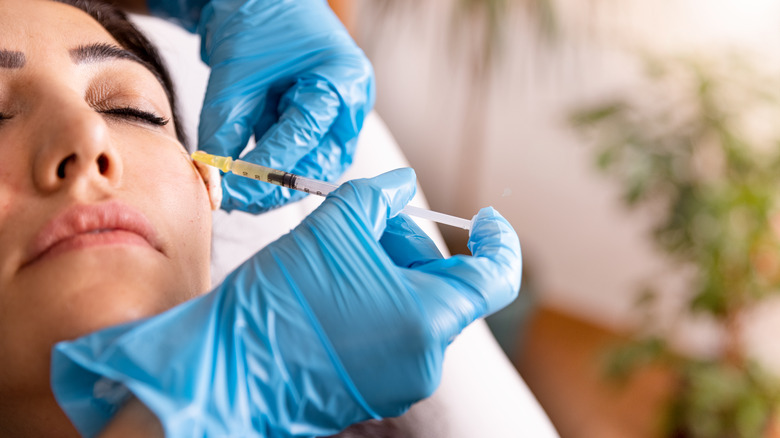How To Tell If You're Experiencing Filler Migration (And Where It's Most Common)
Having fillers injected can be an exciting time, yet nerve-wracking time. People lean towards injectables for a list of reasons. Fillers can improve the appearance of wrinkles, increase lip size, and plump up cheeks, among other things. Improving your looks can be a great self-esteem booster. However, as with any cosmetic procedure, there are several things that could go wrong. One major concern among patients and medical professionals is filler migration.
This phenomenon takes place when the filler moves from its intended location to a different area of the face. For example, if you've had fillers injected into your left cheek but it moves downward towards your chin, that means you have experienced filler migration. One tell-tale sign is experiencing fullness in an undesired region of the face that has not received any filler. Thankfully, filler migration is not super common. Still, if you intend on making fillers a part of your standard beauty regimen, it's important to correctly identify filler migration and ways to prevent it.
Filler migration is more noticeable in certain areas
The risk of filler migration will linger as long as you get injections. However, there are some areas where the chance of filler movement are more common. Board-certified dermatologist Dr. Noëlle Sherber spoke with Women's Health, where she explained that migration will typically occur in the lips, tear troughs, and central cheeks. Sherber also points out that filler migration is seen within the Nasolabial folds, the skin running from the corners of your lips to both sides of your nose. Even with hyaluronic acid being the most commonly used filler and the safest, Dr. Sherber says it's not exempt from migration, one type being an accidental injection into the blood vessels.
This more dangerous type of migration happens when the filler is injected into a blood vessel. This occurs when the needle is inserted too deeply into the skin, bypassing the intended site and entering the bloodstream. This can lead to a condition known as vascular occlusion, per the American Board of Facial Cosmetic Surgery, which happens when the filler causes a blockage in the blood vessels.
Lips appear hard when filler migration has occurred
Filler migration in the lip region has the most identifiable look of all. "Duck lips" is how many experts describe them. They protrude outward with a hardened look that makes the mouth appear stiff. Filler can migrate away from the lips and cause the heaviness and puffiness above the mouth known as a "filler mustache." Dr. Dr. Noëlle Sherber, dermatologist and co-founder of SHERBER+RAD, explained to Women's Health that migration happens when an area is continuously injected, despite being overfilled.
"With filler treatment, if an area is overfilled, then there is tension in the tissue, and the soft gel will make its way out of the area with more pressure into an area of less pressure," Dr. Sherber stated.
So how do you prevent such undesirable results? Well, the first step is finding a qualified injector. While different states may have different standards for who is allowed to perform injections, finding a board-certified plastic surgeon or dermatologist to administer fillers may be the safest way to go, as they are medically trained. Another way to limit the chances of filler migration is by avoiding rubbing and squeezing your face for at least 24 hours after receiving the fillers. If filler migration does take place, you can always get your filler dissolved or allow it to dissolve naturally. Though there is always the risk, these tips can help you have the best experience possible.
